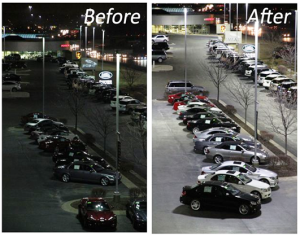“There are many levels of savings possible through energy efficiency upgrades.”
Rising energy use and costs are reducing company profitability. Our client’s primary goal when they engage us is often to simply reduce their energy expense. In many cases we are able to do that in such a significant way that the cost of the upgrades are paid for out of the money saved from the reduced energy use. What they don’t expect to receive are the following valuable consequences. These are examples from recent client projects:
1. Reduced Cost of Maintenance – one light bulb that we install has three times the lifespan of the bulb it replaces. That results in one third less bulb replacements over a lifetime of use. In an industrial setting replacing bulbs suspended from a high ceiling often requires a scissor lift and maintenance staff, two big expenses. Cutting the frequency of replacements greatly reduces those two costs.
2. Improved Light Quality – some older industrial bulbs have a yellowish tinge to the light. One valet operation that we worked with complained that their staff was having a hard time finding cars for customers. The cars were acquired in a natural light setting and the color and make of the car was noted on a claim ticket. The cars were then parked in a structure that used lights with a yellowish tinge. The result was confusion and delays while attempting to retrieve cars that looked nothing like the color listed on the claim ticket due to the yellow light  distortion. Automobile dealerships, with large show rooms and car lots, depend on accurate color replication. High quality light (as opposed to the flicker and buzz of some fluorescent lights) has also been shown to improve health and increase productivity in the work place. New advances in light technology (LED, induction, etc) can reproduce light quality that is similar to outdoor light and at a fraction of the cost of the technology being replaced.
distortion. Automobile dealerships, with large show rooms and car lots, depend on accurate color replication. High quality light (as opposed to the flicker and buzz of some fluorescent lights) has also been shown to improve health and increase productivity in the work place. New advances in light technology (LED, induction, etc) can reproduce light quality that is similar to outdoor light and at a fraction of the cost of the technology being replaced.
3. Reduced Contractor Fees – One of our alliance partners uses a system of wireless nodes to overlay a buildings electrical system. With a few clicks of a computer they can completely reconfigure the lighting for any change in production or workspace usage. In the past, what would often require the hiring of a licensed electrician is now done in seconds with the click of a mouse! A huge savings needless to say.
4. Automatic Savings – Installing energy efficiency products provides one level of energy saving. Automatically turning the product off or minimizing its usage provides an extra level of savings. Many production facilities can cut their light usage when the sun is shining but, if it’s left up to staff, it often doesn’t get done. When you automate the process of dimming lights or shutting off lights or equipment with light sensors, occupancy sensors or preprogrammed equipment off times (breaks, shift changes, vacations etc.) the savings become automatic. When turning off lights is not dependent on staff the resultant savings are an added bonus.
5. Increased Production – The Energy Alliance Group recently provided an energy efficiency upgrade to a facility that processes 1000’s of cars per week. At the end of the production line each of those cars were transferred to a parking lot through antiquated, industrial sized garage doors. That step required the driver to get out of the car, push a button for the door to rise, drive out and reverse the process to close the door. The old doors took about 20 seconds to open and 20 seconds to close with a 30 second hold time. The complete cycle took 70 seconds! This let out lots of heat in the winter and brings in lots of heat in the summer. EAG installed high speed, sensor activated, energy efficient doors and now a car simply pulls up to the door, it opens automatically in 8 seconds, the driver drives out, and the door closes in 8 seconds. That saved a lot of lost energy but it also greatly reduced the time required for one step of the operation which resulted in an increase in production.
There are many levels of savings possible through energy efficiency upgrades. The unintended consequences of those upgrades can greatly add to the profitability of a company operation. The Energy Alliance Group of Michigan takes the unintended consequences into consideration on every project and looks for the optimum factors to archive the ideal results for our clients. One of those factors is financing. Learn more HERE!
The Energy Alliance Group of Michigan is a leader in clean energy PACE project development and financing.

Leave a Reply